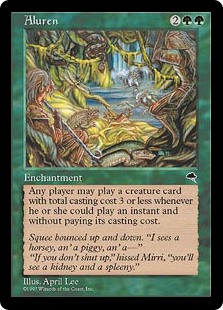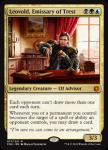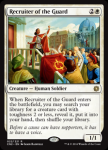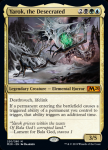Oversoul
The Tentacled One
Playing with Aluren in EDH again inspired me to start a Magic Memories thread for the card. I didn't do it at first, but I'm starting one now. I've had a fondness for this card for something like 20 years and I've built decks around it multiple times, but actually I've overall used it much less than most of the other entries in the Magic Memories series. In part, that's a consequence of the general inflexibility of this card. Staples like Dark Ritual, Regrowth, and Survival of the Fittest get used again and again in various archetypes. Even more obscure cards like Soldevi Digger and Sengir Autocrat are ones I've managed to throw in a lot of decks over the years. But Aluren is always a card that's exclusive to "the Aluren deck." Whatever that deck might look like...

I was enthralled with this card ever since I first read it, some time in the late 1990's when I was still inexperienced and distinctly naive about the game. Perhaps one reason that Aluren stands out so much in my mind is that my view of the card hasn't really evolved, unlike my views of most other cards from back then. I mean, I've gotten some practice with it and there are powerful new synergies that didn't exist at the time, but the core aspects of Aluren as a functional Magic card remain unchanged, and I guess I recognized them even when I was young and stupid.
With Aluren, you're pretty much stuck with these features...
An early attempt at making Aluren work was one of the Tempest precons, called "The Swarm."
14 Forest
7 Plains
2 Vec Townships
1 Elven Warhounds
1 Krakilin
3 Master Decoy
4 Muscle Sliver
3 Pincher Beetles
2 Ranger en-Vec
3 Rootwalla
3 Skyshroud Elf
1 Soltari Crusader
2 Soltari Trooper
3 Trained Armodon
1 Aluren
3 Pacifism
1 Recycle
1 Anoint
1 Disenchant
1 Elvish Fury
1 Needle Storm
2 Overrun
Yikes, that list is bad. Well, with only one copy of Aluren, you probably just aren't getting the card anyway, but if you do cast it on turn 4, you can rush out a sizeable attacking force. Elven Warhounds and Krakilin don't synergize with Aluren, but the other creatures can all come down on a single turn from one's hand. But it's clunky, unreliable, and ploddingly slow for a beatdown deck by today's standards.
I was enthralled with this card ever since I first read it, some time in the late 1990's when I was still inexperienced and distinctly naive about the game. Perhaps one reason that Aluren stands out so much in my mind is that my view of the card hasn't really evolved, unlike my views of most other cards from back then. I mean, I've gotten some practice with it and there are powerful new synergies that didn't exist at the time, but the core aspects of Aluren as a functional Magic card remain unchanged, and I guess I recognized them even when I was young and stupid.
With Aluren, you're pretty much stuck with these features...
- You can cast your cheap creatures (3 mana or less CMC) for free.
- You can cast those cheap creatures at instant-speed.
- Your opponents can do the same.
- The card does nothing with more expensive creatures.
- The card does nothing for non-creature spells.
- To break the symmetry on this, you need to load up your deck with cheap creatures.
- Those cheap creatures may not do much without Aluren.
An early attempt at making Aluren work was one of the Tempest precons, called "The Swarm."
14 Forest
7 Plains
2 Vec Townships
1 Elven Warhounds
1 Krakilin
3 Master Decoy
4 Muscle Sliver
3 Pincher Beetles
2 Ranger en-Vec
3 Rootwalla
3 Skyshroud Elf
1 Soltari Crusader
2 Soltari Trooper
3 Trained Armodon
1 Aluren
3 Pacifism
1 Recycle
1 Anoint
1 Disenchant
1 Elvish Fury
1 Needle Storm
2 Overrun
Yikes, that list is bad. Well, with only one copy of Aluren, you probably just aren't getting the card anyway, but if you do cast it on turn 4, you can rush out a sizeable attacking force. Elven Warhounds and Krakilin don't synergize with Aluren, but the other creatures can all come down on a single turn from one's hand. But it's clunky, unreliable, and ploddingly slow for a beatdown deck by today's standards.






